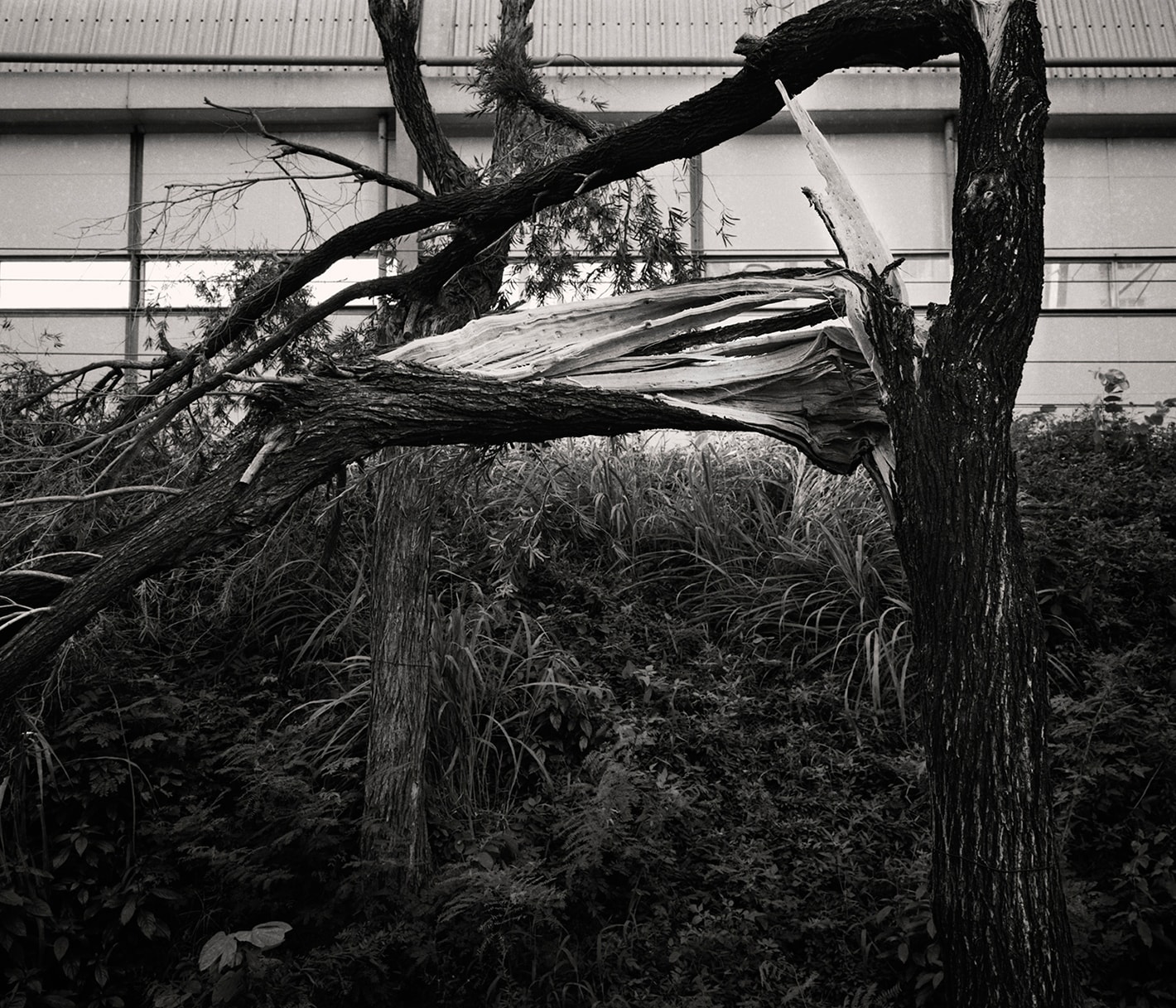
Ho Siu Nam exhibited his latest photography series “The White of the Tree” (2018). The work records the face of the super typhoon Mangkhut that hit Hong Kong the same year. The strongest tropical cyclone since the 1980s caused extensive damage to Hong Kong. Thousands of tree branches broke and were uprooted. The artist captured the body and wounds of the trees after the natural disasters, recording the vulnerability of the individual under strong violence, such as during the shooting.
In addition to the photographic works, Ho Siu Nam also exhibited two wood carvings. Every living plant, in the time and space that it survived, must have been associated with people and things around it with different stories and memories. For these works he used the names of daughter, bridge, and mother.
People set up monuments for heroes and memorable events; Ho Siu Nam commemorates trees. Just as after the typhoon, people will return to ‘normal’ as soon as possible, and will not think twice when they quickly clear the broken branches and leaves, and all the things that hinder normality will disappear.
Mr Ho once left the sky blank in one of his photographic works, and then randomly filled in the squares in 12 colors. He deliberately chose only yellow, blue, green and red to fill the sky. ‘Yellow’ represents demonstrators who advocate peace, rationality, non-violence and support for renegotiation. This color is derived from the 2014 Yellow Umbrella Movement. ‘Blue’ stands for those who support the government and support the police, ‘Green’ is the uniform color of the Hong Kong anti-riot police, and ‘Red’ is the color of the Chinese government. The four symbolic colors in the photo shrouded the earth, while they summarized and fully reflected the current social situation in Hong Kong.

When I was a child there were only iron bars on the window and no glass. Every time a rainy day came, my mother would place a long rubber sheet on the window to protect us from the wind. Since childhood, Ho Siu Nam ’s impression of the pitted rubber sheet is to protect his family and guard his home. In the recent political movements in Hong Kong, anti-riot police often use long sheets to protect themselves. Whether confronted with demonstrators or advancing to disperse people, the police hold up long shields and knock on the ground to create a giant whistle to warn demonstrators. Is the role of these anti-riot long shields for protection or to drive people away? Because of the similarity of the shape of the windshield and the police anti-riot shields, the artist copied a whole row of anti-riot shields with transparent pitted panels and installed them on the exhibition window. Ho Siu Nam ’s self-made rubber sheet long shield is also titled “could not be intimidated artist”. What about the general public? What can they do?

There is another response to the political movement: the sponge bomb. Despite its cute name, it is obviously a lethal weapon. The artist gives it a bright color to make it even more appealing. The truth is that the momentum of shooting with firearms is definitely not the general idea of a ‘sponge’.
Since June, a wave of millions of people have marched and demonstrated in the streets and more have continued to emerge. During the protesting, everyone has shouted slogans and made demands. Ho Siu Nam recorded many demonstrations and recorded these slogans. The audience is invited to listen carefully, understand the demands of the demonstrators, and understand the mentality of the demonstrators at this time. In the latter part of the video, the impact begins. When the exhibition opened, the movement was still developing; what will happen in the future?
After the super typhoon Mangkhut, Hong Kong people who are eager to restore their city’s appearance will redefine the word ‘normal’ in this ongoing political, man-made storm. As a resident of Hong Kong, I have experienced countless typhoons, lived in public housing, and been touched by the development process of this political movement from different perspectives. After viewing this “force majeure” solo exhibition, there is an indescribable deep experience in my heart.
Leung Suk Ching
Volume 34 no 3 January – February 2020 pp 10-11
Hong Kong Blindspot Gallery September 10th – November 2nd, 2019
…………………………………….
兩位藝術家:程展緯與何兆南,於香港刺點畫廊一起舉辦雙個展 ‟液化陽光 | 不可抗力”
展期:2019年9月10日 -11月2日
文:梁淑楨
液化陽光:
位於亞熱帶的香港,每年夏季都有颱風來襲,對香港人而言,颱風這種自然災害造就了眾人的集體記憶,同時亦塑造了一種應對風暴的社會集體意識。在這集體記憶和意識下,兩位藝術家不約而同地以近年的颱風為引子,準備是次展覧作品。作品的創作年期巧合地遇上香港近年的兩次主要政治運動,因此,作品中不難窺見藝術家除了申說自然界風暴帶來的災害,同時也
人為的政治風暴作出回應。
先談談程展緯:‟液化陽光”。他為今次個展挑選展品所抱的準則是「似曾相識」、「舊事常新」。是他曾經在台灣展出的作品,明信片的畫面是香港及台灣的建築和風景,畫面陽光普照,光彩明亮。藝術家發現在眾多明信片中難以找到雨景。為甚麼?因為有太陽的日子才是「日常」?下雨則是「非日常」?人們都愛日常?而非日常的東西是否可以變成日常?連串問題令藝術家萌生要在明信片上把陽光液化的想法,他以素描方式,一筆一筆的加上雨絲:一滴、兩滴、三滴……直至明信片上本來的景物模糊後退,雨水成為畫面主題。一張張滿佈雨絲的明信片被掃描後製成錄像,畫面不停播映,就像電腦的螢幕保護畫面,我們不知它從何時開始,也不知它在哪兒結束,雨水畫面綿延不斷,陽光被液化會成為常態嗎?在現時的政治氣候下,香港這場政治風雨會一直下不完嗎?
2014年台灣太陽花學運,警察出動水炮車驅散民眾。兩星期後,香港大型商場又一城在暴雨期間,室內大肆漏水,出現多處水濂雨景,這兩個現實而魔幻的景像觸動了程展緯,他因此想製造兩場分別在香港藝術館和台灣當代藝術館門前的人造雨景。藝術家去信台灣政府借水炮車,說明水炮車不會射向人民,只會射向天空,到水點無力下墜成為雨景。點點雨水滴在皮膚上,滴在大地上,雖無力但深刻,因為在藝術家心中,出動水炮車等如拒絕溝通,就像電影中鬧翻的情侶,拿水杯向對方潑水,宣示要終止對話一樣。港台兩地人造雨景的表徵和意念是一致的,所不同的是台灣水炮車內注的是台灣的水,而香港的水炮車內所注的,卻是來自中國大陸的東江水。
程展緯取得當保安員資格後,第一天上班就遇上颱風,整棟廠房只剩他和維修師傅。作為保安員要負責透過閉路電視(cctv)監察周遭情況。場中展示的每個電視畫面錄影了颱風下廠房的不同角落。其中一個畫面比較特別,它錄得蜘蛛在鏡頭前爬過,沒有爬過的蜘蛛,不會發現原來鏡頭上結了蜘蛛網,這情景引出一個有趣的概念:cctv是隱閉的,但它存在於各個角落;蜘蛛網是隱藏的,但它在你眼前卻能不被發現;颱風是透明的,但它的出現會引起全城關注。這種隱藏與存在、存在與隠藏的奇幻關係令程展自緯覺得非常有趣,透過作品的錄影畫面,你我亦不妨深思一下這個饒具哲學意味的課題。
2013年,藝術家繼續以保安員身分到火車鐵路博物館上班。待參觀者全部離開後,作為保安員的藝術家當一刻覺得自己擁有整個博物館的空間,那是一種奇異的超現實感覺。博物館中的火車車廂光線一邊光,一邊暗,氣氛猶如日夜交替,程展緯於是在鏡頭前舞動制服,拍攝效果有如一片雲在空中飄動,並穿越日與夜。藝術家當年純粹因喜愛這意境而創作的作品,沒想到今天竟讓人聯想到政治運動中警察的制服。兩個不同時空的景像,竟因著「制服」而產生連結,同樣是快速的模糊影像,但前者飄逸後者躁動,予人的是兩種截然不同的感覺!
自六月政治運動開始,香港警察在不同場合會以「曱甴」(即蟑螂)二字統稱示威人士,以去人性化的方法矮化對方的尊嚴,把驅散示威者視為打曱甴行動。「曱甴」是程展緯十多年來的創作主題之一。本身對曱甴恐懼的藝術家,用膠紙憑空想像其形態結構,多年來製作過千隻。他從來沒有根據圖片及實物,因為害怕,所以不會看圖研究,更遑論實物觀察。程展緯認為恐懼會製造影像,他製作的曱甴形態都是基於印象,再加上恐懼而想像出來的。錄影部分是新拍的,
舊的錄影内容一樣,是敎人製作膠紙曱甴的過程,但新拍的把膠紙物料抽走了,畫面只有一雙手在活動,其他的由觀眾自己想像。吊詭的是,影片中隱藏了一張快速閃過的照片,主角是驅趕示威人士的防暴警察,這是香港近日政治運動中常見的畫面。加插這照片意味著甚麼?防暴警察認為自己在打曱甴?但畫面沒有出現任何曱甴,警察所打的是自己心中想像的影像嗎?而這影像又是否由恐懼製造出來的?筆者相信不同身份的觀眾會有不一樣的答案。
颱風來臨時,曱甴會亂撞亂飛,是躁狂的,而白鴿飛則是牠的生活活動,牠的日常,兩者全然不同。當白鴿與曱甴在同一空間飛動,牠們如何找到彼此的活動界線。程展緯認為邊界本身看不見、觸不到,這個存在但又隱藏的邊界到底如何體現出來?是碰撞!以身體碰撞而顯示出界線的存在!就像作品中白鴿和曱甴分別飛動 — 砰 — 碰撞 — 邊界出現!衝擊、碰撞就是讓人知道界線在哪,當身體遇到碰撞,人們就知道自己已觸碰到別人的邊界了。身體如是,言語如是,價值觀亦如是,砰 — 碰撞 — 邊界出現!
不可抗力:
「不可抗力
是一個法律用語,一項免責條款。意指當出現不能預見、不能控制的自然現象(如颱風、地震、海嘯)或社會現象(如暴亂、罷工、政府干預、戰爭行為)時,合同契約中的當事人因此而不能履行合同,違約一方可部分或者全部免除違約責任
原來由颱風、罷工造成的違約可以免責。
何兆南展出他最新的攝影系列《樹的留白》(2018)。作品記錄了2018年超級颱風山竹吹襲香港後的面貌。這個自1980年代以來最強的熱帶氣旋對香港造成廣泛破壞,成千上萬的樹木裂枝斷幹,橫斜歪倒日常所見的石屎森林面貌完全變形,景像撼動人心。藝術家捕捉了樹木在天災重創後的軀體和傷口, 記錄了在強大暴力下個體的脆弱,同時在拍攝的過程中,發現倒下的樹木很快被走,從中可見整個城市對回復正常狀態的迫切渴望。
除攝影作品外,何兆南也展了出兩件木雕,材料來自白千層。每株有生命的植物,在存活過的時空中,必然曾經跟周遭的人、事、物發生過關聯,當中應有不同的故事及回憶。這個以女兒、橋、母親為主旨的作品,你覺得它在訴說著怎樣的故事?它給你帶來了甚麼聯想?
這作品名為1/3先生,藝術家把被砍原樹的三分一保留下來,以直立式呈現,營造「紀念碑」的感覺。人們會為英雄、值得紀念的事件立碑,何兆南要為樹木立碑紀念,因為原本有著隔音、過濾空氣,甚至藥用價值的樹木,當其功能可被取代後,它的存在價值是否就可以不受重視?正如風災過後,人們為了儘快回覆「正常」,會不作任何考慮把折樹快速清場,一切阻礙回復正常的都要消失。地球一直由人類主宰,其他物種只能被受支配,喜歡正常的人類,可有思考過這種獨大心態又是否正常?
曾經在攝影作品中把天空留白,然後以12種顏色,用擲骰子的方式隨機填上色彩方塊。藝術家今次為個展創作時,正值遇上香港政治運動,他特意只選擇黃、藍、綠、紅四色填塗天空的留白。「黃」代表主張和平、理性、非暴力,支持返修例的示威人士,這顏色源自2014黃雨傘運動。「藍」代表支持政府、支持警察的人;「綠」是香港防暴警察的制服顏色;而「紅」就是中國國家的色彩。相片中四種極具象徵意義的色彩籠罩大地,概括而充分地反映出香港現時的社會情況。
小時候家住舊式「公屋」(香港政府建築的樓宇),窗上只有鐵枝圍欄,沒有玻璃。每逢颱風或雨天,媽媽會裝上長形的坑紋膠板,為家居擋風遮雨。因此,始自孩提時代,何兆南對坑紋膠板的印象就是保護家人、守衛家園。在香港近日的政治運動中,防暴警察經常出現大街小巷,無論在與示威人士對峙或向前推進驅散人群,警察都手執長盾,也會以之敲打地面,製造巨響鎮攝示威者並警告不可衝擊。防暴長盾的作用是保護?是驅趕?由於擋風遮雨的坑紋膠板造型外貌與防暴盾有九分相似,藝術家因此以透明的坑紋膠板仿製了一整排的防暴長盾,安裝在展場窗上。這作品喚醒了筆者的兒時記憶,也引領筆者對保護家人、守衛家園的定義作重新思考。警察和長盾所保護、所守衛的到底是甚麼?手執長盾的警察警告示威者「不可衝擊」;何兆南手執自製膠板長盾也叫「不可衝擊藝術家」;而一般市民呢?他們可以手執甚麼?可以叫喊甚麼?
這是對政治運動的另一回應作品:海綿彈。明明就是具殺傷力的武器,擁有的一方會以軟性的名字淡化民眾意識,藝術家賦予鮮艷色彩,使之更見可愛。「海綿」是何其柔軟的物料啊!真的會令人誤信:「就是被射中也不會受大傷害」。實情卻是,透過槍械射擊出來的衝力絕對是非一般的「海綿」力量!
六月以來一波又一波的百萬人遊行示威,無間斷湧現街頭,遊行期間眾人齊喊口號,申明訴求。何兆南這錄像作品記錄多次遊行情況,也記錄了當中的口號內容,觀眾可以細心聆聽,從中認識示威者的訴求,也可認識這些日子裏示威者的心路歷程。錄像後段,開始出現衝擊場面,直至展覽開始,運動仍在發展中,未來結果會如何?社會何時會回復平靜?一切未知。
山竹颱風過後,急切追求市面回覆正常的香港人,在這次持續的政治人為風暴中,對於「正常」二字會否重新定義?大型遊行會成為日常?防暴警察以長盾、海綿彈維持秩序又會否成為日常?作為香港一份子,筆者同樣經歷過無數颱風、同樣住過公屋、也同樣從不同渠道接觸到是次政治運動的發展過程,在看何兆南這個”不可抗力”個展後,有不可言喻的深刻體會。
作者為香港某高中美術老師,台灣師範大學美術系畢業

Brave work. I suppose the colours in the sky were explained in a key?
Not really, he did say a few words about colours in the article but we never received a detailed list – they are all pseudo-political though.
Leung Suk Ching wrote, “After the super typhoon Mangkhut, Hong Kong people who are eager to restore their city’s appearance will redefine the word ‘normal’ in this ongoing political, man-made storm.” Redefining what is “normal” is what people in most countries are currently forced to do in the face of this super typhoon called Covid-19, while living their various levels of lock-downs and quarantines. What is normal? How is normal reflected in our artwork?
What a good question. What is normal? I wonder if the concept of normal is the same in Chinese culture as it is in western culture.
Hi Derek,
Thank you for your comment. In your opinion, what is normal in western culture?
Normal is what people are used to.